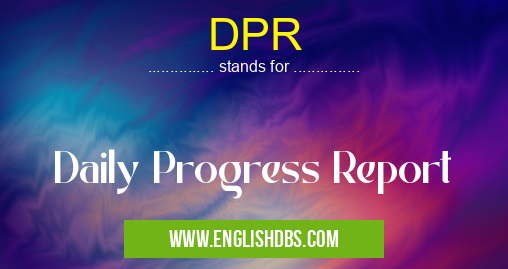What does DPR mean in GENERAL
Daily Progress Report (DPR) is a crucial part of a business’ operations. DPRs offer an accurate look at the progress of a project or the current state of any task. This helps the managers to stay on top of the process and manage their resources efficiently. A Daily Progress Report also helps in tracking the performance of an organization over time, measuring progress, and setting goals for future growth. With daily monitoring, managers can easily identify issues that might affect timelines or performance and address them before they become bigger problems.

DPR meaning in General in Business
DPR mostly used in an acronym General in Category Business that means Daily Progress Report
Shorthand: DPR,
Full Form: Daily Progress Report
For more information of "Daily Progress Report", see the section below.
Definition
A Daily Progress Report is a document that details what work has been done during a specific day, typically by an employee or team member. The report includes updates on particular tasks and activities completed as well as any challenges that might have been encountered along the way. It can also include estimates on how much work still needs to be done to complete the overall project or task being reported on.
Advantages
The primary benefit of Daily Progress Reports is their ability to keep stakeholders informed about progress so they can make sure that people are staying on track with timelines and deliverables. They provide insights into who is making progress and who may need more guidance or assistance in order to reach goals set out for the project or task. Additionally, DPRs help team members stay accountable for assigned tasks since their progress will be tracked closely through regular reporting requirements. Finally, DPRs can be used as reference points to compare against future milestones in order to determine areas needing improvement or additional resources for future projects.
Essential Questions and Answers on Daily Progress Report in "BUSINESS»GENERALBUS"
What is a Daily Progress Report (DPR)?
A daily progress report (DPR) is a compilation of information used to monitor the progress of a project or task. It is usually generated regularly to ensure that goals and deadlines are being met and also to provide visibility into the project's current status.
How often should DPRs be submitted?
The frequency of submitting DPRs will vary depending on the type of project and the timeline agreed upon. Generally, it is recommended that at least one DPR is submitted per day or per week, depending on the scope of the work.
Who should submit DPRs?
All individuals involved in completing tasks along with their managers should submit Daily Progress Reports. This ensures that each participant’s progress can be monitored effectively by managers and team leaders.
What kind of information should be included in a DPR?
A Daily Progress Report should include specific details about progress made including any milestones achieved, tasks completed, issues encountered or challenges faced during the course of the workday/week, as well as any corrective steps taken where necessary.
What format should a DPR take?
Depending on the organization and workflow, the format taken by DPRs may vary. However, generally they should consist of detailed comments instead of just basic checklists. It could also include images or screenshots if needed to explain certain processes more clearly.
How can DPRs help improve productivity?
By submitting regular updates via Daily Progress Reports, employees are able to track their own performance which helps boost motivation and encourages them to become more productive in their roles. Likewise , managers can refer back to previous reports to measure potential areas for improvement across teams & departments.
Are there any other benefits associated with utilizing DPRs?
Yes,utilizing Daily Progress Reports provides an opportunity for communication with upper management; providing them with clear visibility into exactly how individual tasks are progressing as well as overall performance across projects within an organization.
Is there an ideal time period for sending out DPRs?
Ideally, reports are sent out before end of working hours everyday or at least once every 7 days-whichever suits best depending on the timeline agreed upon between manager & employee.
Final Words:
In conclusion, Daily Progress Reports are invaluable tools for businesses when it comes to monitoring and evaluating progress towards desired outcomes. They provide stakeholders with valuable insights in real-time so that decisions can be made effectively and changes can be implemented quickly if necessary. Furthermore, DPRs help organizations maintain control over resources by providing visibility into how efficiently tasks are being completed across teams and departments. Overall, DPRs are essential components of successful business operations if used correctly with consistent reporting structures during all stages of a project's lifecycle.
DPR also stands for: |
|
| All stands for DPR |
